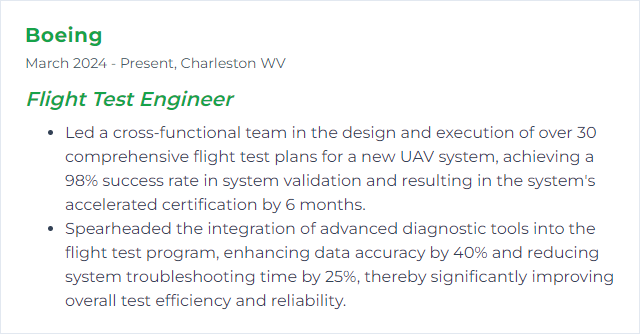Top 12 Flight Test Engineer Skills to Put on Your Resume
In aerospace, standing out as a flight test engineer means putting the right skills front and center. The dozen below signal sharp judgment, hands-on depth, and the kind of systems thinking that makes flight data sing and aircraft safer.
Flight Test Engineer Skills
- MATLAB
- Simulink
- Python
- LabVIEW
- CATIA
- SolidWorks
- ANSYS
- DO-178C
- DO-254
- C++
- Avionics Integration
- Systems Engineering
1. MATLAB
MATLAB is a high-level programming and numeric computing environment used for data analysis, algorithm development, and visualization. In flight test, it’s a daily driver for processing flight data, modeling dynamics, and crafting control logic quickly and repeatably.
Why It's Important
It slashes analysis time, makes large datasets manageable, and supports simulations that de-risk flight. Better clarity. Better control. Fewer surprises.
How to Improve MATLAB Skills
Dial in the parts that matter to flight test—data wrangling, model development, and clean visualization.
Build a solid base: Learn vectors, matrices, scripting, and functions until they’re second nature.
Get serious about plots: Craft clear, high-density visualizations for time histories, envelopes, and residuals.
Use Simulink alongside: Model flight dynamics, actuators, and control loops, then link results back to MATLAB for post-flight analysis.
Adopt Aerospace Toolbox/Blockset: Use built-in flight dynamics, units, and environment models to speed up credible simulations.
Practice with real data: Work from raw flight logs—sync, filter, align, and validate against test cards and truth sources.
Automate your workflow: Write reusable scripts and live scripts; package common routines into functions and toolboxes.
Keep learning: Iterate on code reviews, read release notes, and benchmark your scripts for speed and memory.
How to Display MATLAB Skills on Your Resume
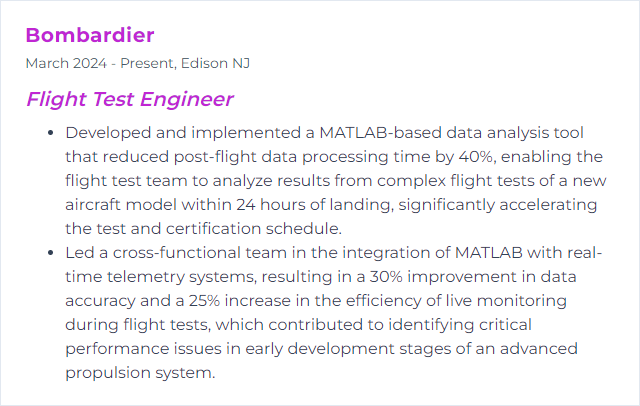
2. Simulink
Simulink is a graphical environment for modeling, simulating, and analyzing dynamic systems. For flight test engineers, it’s the bridge between control theory and hardware reality.
Why It's Important
You can prove out control logic, plant models, and fault responses before wheels leave the ground. Safer tests. Cleaner debriefs.
How to Improve Simulink Skills
Boost model fidelity: Use aerospace blocks, atmosphere models, and actuator dynamics with realistic lags and saturations.
Run in real time: Set up hardware-in-the-loop or rapid prototyping to exercise code paths before flight.
Wire in flight data: Replay recorded telemetry to validate models, tune observers, and refine limits.
Standardize libraries: Build reusable subsystems with versioned requirements and test harnesses.
Profile and test: Add assertions, coverage, and automated checks; keep models fast, readable, and traceable.
How to Display Simulink Skills on Your Resume
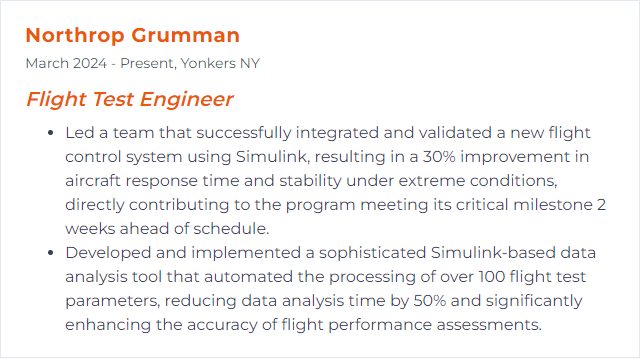
3. Python
Python streamlines data handling, automation, and quick-turn tools. It’s the glue that stitches logs, plots, and reports together without fuss.
Why It's Important
Rapid scripting means less time fiddling and more time learning from the data. Automation reduces errors. Your team moves faster.
How to Improve Python Skills
Own the data stack: Pandas for tabular data, NumPy for arrays, SciPy for math, and Matplotlib/Seaborn/Plotly for visuals.
Automate the boring stuff: File parsing, data validation, report generation, and batch analyses.
Talk to hardware: Practice serial, UDP/TCP, and file-based interfaces; build robust parsers for bus messages.
Go faster: Vectorize operations, cache results, and profile hotspots; consider Numba or C++ bindings when needed.
Improve code quality: Adopt a consistent style, type hints, unit tests, and linting; structure projects with clear packaging.
Version everything: Use Git with meaningful commits, branches, and reviews; tag analysis baselines for traceability.
How to Display Python Skills on Your Resume
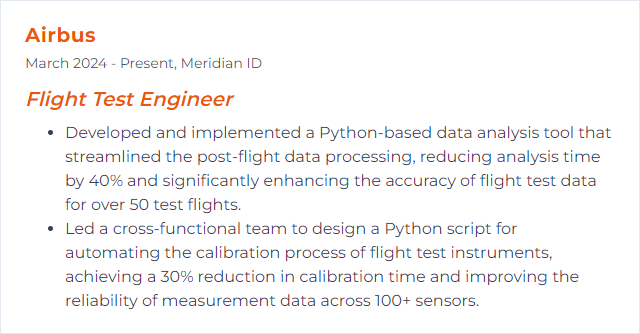
4. LabVIEW
LabVIEW is a visual programming environment from NI for data acquisition, control, and test automation. In flight test labs and telemetry rooms, it shines.
Why It's Important
It delivers fast, reliable DAQ, real-time monitoring, and rugged control. When seconds matter and signals drift, you’ll see it.
How to Improve LabVIEW Skills
Lock in fundamentals: Master dataflow, VI organization, queues, events, and error handling.
Start from templates: Use well-structured reference designs and tailor them—don’t reinvent logging or UI scaffolding.
Get DAQ-savvy: Configure timing, triggering, buffering, and synchronization for high-rate, multi-channel systems.
Analyze in-line: Implement filters, FFTs, statistics, and health monitoring without dropping samples.
Push to real time/FPGA: Offload critical paths and latency-sensitive logic to Real-Time or FPGA targets.
Document and test: Add built-in self-tests, simulation inputs, and clear operator prompts; version your VIs.
Validate skills: Certifications (CLAD/CLD/CLA and Real-Time/FPGA tracks) help demonstrate depth.
How to Display LabVIEW Skills on Your Resume
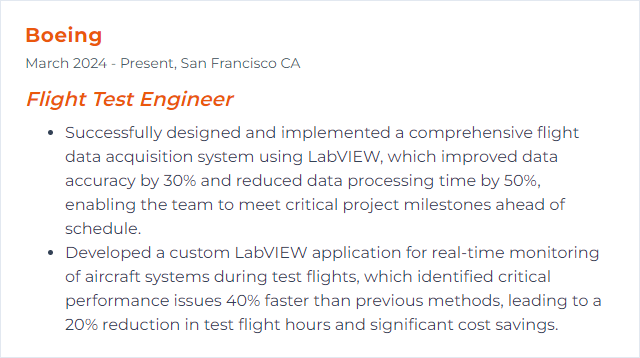
5. CATIA
CATIA supports CAD/CAE/PLM workflows for complex aerospace structures and mechanisms. For flight test engineers, it’s how you understand geometry, clearances, and the knock-on effects of change.
Why It's Important
Accurate models and assemblies reduce late surprises. Good digital mockups mean smoother instrumentation installs and safer test points.
How to Improve CATIA Skills
Focus on key workbenches: Part Design, Assembly Design, and Generative Shape Design for aero-relevant geometry.
Practice with real hardware: Build representative test racks, sensor mounts, and access provisions; check maintainability.
Leverage analysis: Use integrated analysis (including SIMULIA workflows) to sanity-check stiffness, mass, and modal characteristics.
Manage data well: Tie designs into PLM, enforce revisions, and keep a tight change history.
Automate repetitive steps: Use macros or scripts to standardize naming, properties, and exports.
Stay current: Track new releases and aerospace-centric methods; apply company standards for metadata and units.
How to Display CATIA Skills on Your Resume

6. SolidWorks
SolidWorks delivers fast 3D modeling, drawing creation, and integrated simulation. It’s common in test fixture design, rapid brackets, and instrumentation layouts.
Why It's Important
Quick iterations and clear drawings mean hardware shows up correct the first time. Time and money saved.
How to Improve SolidWorks Skills
Master the foundations: Sketch discipline, robust feature order, mates that won’t collapse.
Surface and sheet metal: Create lightweight, manufacturable parts with clean bend allowances and proper reliefs.
Simulation first-pass: Use built-in FEA and motion to catch weak links and bad margins before build.
Automate: Macros and the API help stamp out repetitive work and standardize exports.
Use PDM: Control versions, references, and approvals; link parts to BOMs cleanly.
Template everything: Title blocks, drawing standards, materials, appearances; reduce edits and mistakes.
How to Display SolidWorks Skills on Your Resume

7. ANSYS
ANSYS offers multiphysics simulation across structures, fluids, and thermal domains. Flight test engineers lean on it to understand margins, failure modes, and performance trends before the airplane sees them.
Why It's Important
It predicts how hardware behaves under load, heat, and airflow. You can protect test points and avoid flight-day drama.
How to Improve ANSYS Skills
Build clean models: Sensible geometry prep, defeaturing, and contacts; don’t let the mesh fight you.
Mesh with intent: Use sizing, inflation, and adaptivity; verify independence and convergence.
Validate aggressively: Correlate with ground test and flight data; update material and boundary assumptions.
Chain disciplines: Couple structural, thermal, and CFD where it matters (e.g., hot structures, aeroelastic risk).
Automate studies: Parametric sweeps, optimization, design points; document everything for traceability.
Stay current: Track solver updates, turbulence models, and HPC options to cut runtimes.
How to Display ANSYS Skills on Your Resume
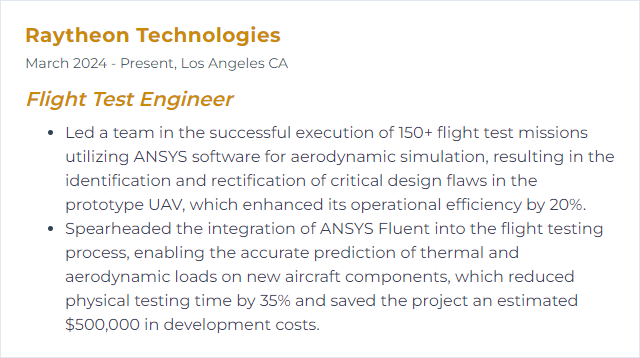
8. DO-178C
DO-178C sets the standard for software development and assurance in airborne systems. It’s the backbone for arguing that flight-critical software behaves safely and predictably.
Why It's Important
Certification hinges on it. Requirements trace to tests, reviews are structured, evidence is auditable, and risk is controlled.
How to Improve DO-178C Skills
Plan early and completely: Produce clear PSAC, SDP, SVP, SQAP, and SCMP documents with agreed processes and objectives.
Enforce traceability: Maintain end-to-end links from high-level requirements to low-level requirements, code, and verification results using robust lifecycle tools.
Strengthen verification: Mix reviews, analyses, unit/integration tests, and robustness testing; verify independence where required by level.
Automate wisely: Use qualified or appropriately assessed tools for static analysis, coverage, and test execution; capture objective evidence automatically.
Control configuration: Version everything—requirements, models, code, tests, results—and lock baselines for audits.
Engage authorities: Coordinate early with FAA/EASA points of contact and DER/DOA teams to align on means of compliance and expectations.
Train continuously: Keep the team current on supplements (e.g., DO-331 MBSE, DO-332 OO, DO-333 formal methods) and common pitfalls.
How to Display DO-178C Skills on Your Resume
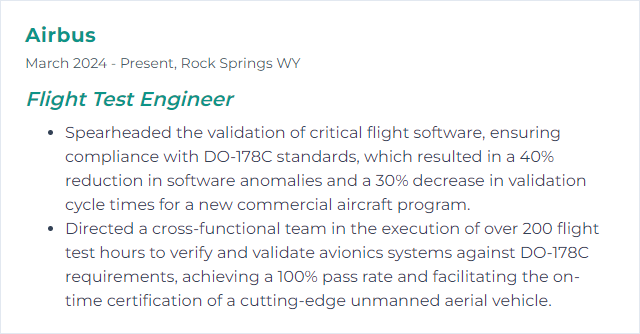
9. DO-254
DO-254 governs design assurance for airborne electronic hardware. Think FPGAs, ASICs, boards—avionics you must trust when conditions get spiky.
Why It's Important
It drives disciplined design, verification, and configuration control for safety-critical hardware. Your flight test depends on it.
How to Improve DO-254 Skills
Know the artifacts: Hardware plans, standards, requirements, design data, and verification evidence—organized and reviewable.
Manage requirements tightly: Trace each hardware requirement to design implementation, tests, and results using rigorous RM tools (e.g., DOORS Next).
Verify like you mean it: Apply simulation, formal methods, and lab tests; use industry tools such as Siemens EDA Questa for verification workflows.
Qualify tools where needed: Follow DO-330 guidance when tools impact product quality.
Control change: Use robust configuration and problem reporting systems; record rationale and impact for every change.
Align with quality systems: Map work to AS9100 and internal processes; audit regularly.
Engage early with authorities: Sync with FAA/EASA expectations and designated engineering representatives.
Upskill the team: Provide focused training on levels, independence, and verification completeness.
How to Display DO-254 Skills on Your Resume
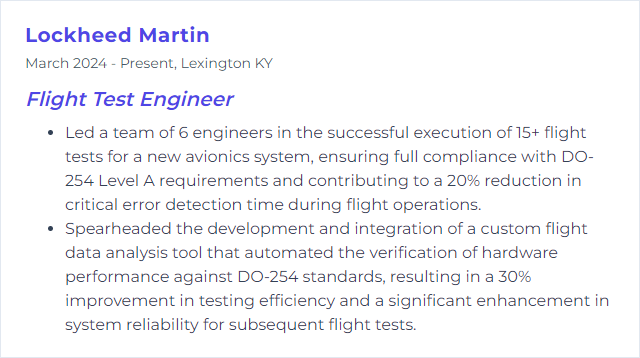
10. C++
C++ powers real-time, embedded, and high-performance applications. In flight test, it underpins simulators, data pipelines, and on-aircraft software where latency and determinism matter.
Why It's Important
You can build fast, memory-aware, reliable tools that integrate closely with hardware and OS primitives. No-nonsense performance.
How to Improve C++ Skills
Lock down fundamentals: Modern C++ (17/20/23), RAII, move semantics, templates, and concurrency.
Lean on the STL: Use standard containers, algorithms, and chrono/filesystem thoughtfully to reduce custom code.
Write testable code: Unit tests, mocks, and fuzzing; measure coverage and timing.
Mind performance: Profile, avoid needless copies, manage allocations, and apply constexpr where it pays off.
Integrate cleanly: Wrap hardware I/O, telemetry parsing, and bus protocols behind stable interfaces.
Practice constantly: Tackle small utilities, parsers, and real-time prototypes; review code with peers.
How to Display C++ Skills on Your Resume

11. Avionics Integration
Avionics integration blends navigation, comms, surveillance, flight controls, and mission systems so they behave as one aircraft. No surprises at the interfaces. No gaps in the data chain.
Why It's Important
Seamless integration is the difference between a clean test card and a grounded aircraft. Reliability and safety depend on it.
How to Improve Avionics Integration Skills
Start with crisp requirements: Define interfaces, timing, data flows, and failure responses clearly.
Use standard buses: ARINC 429/664, MIL‑STD‑1553, CAN, and Ethernet—select wisely and validate timing budgets.
Simulate before you fly: Build rigs, software benches, and HIL setups to shake out protocol and timing issues.
Test comprehensively: Ground test, EMI/EMC checks, environmental conditioning, and robust flight test cards with contingencies.
Collaborate relentlessly: Keep avionics, software, instrumentation, and flight crews aligned with disciplined issue tracking.
Document evidence: Keep ICDs current, log anomalies with root cause and corrective action, and version all artifacts.
Grow expertise: Pursue relevant certifications and stay sharp on new protocols and cybersecurity considerations.
How to Display Avionics Integration Skills on Your Resume
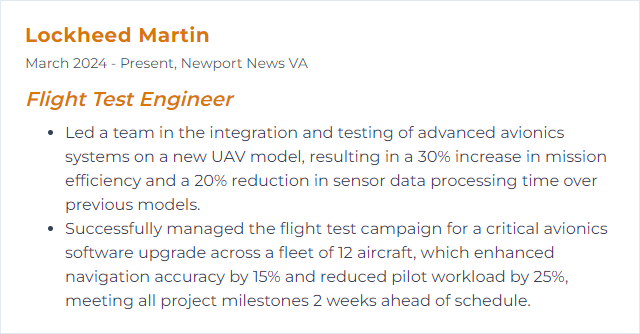
12. Systems Engineering
Systems engineering is the discipline of building the right thing—and making sure it works together end to end. For flight test, it ties requirements, design, verification, safety, and operations into a coherent whole.
Why It's Important
Complex aircraft don’t forgive sloppy integration. Systems thinking keeps risks visible, decisions traceable, and tests meaningful.
How to Improve Systems Engineering Skills
Think in interfaces: Map functions to interfaces and states; capture assumptions explicitly.
Adopt MBSE: Use SysML and model-based workflows to visualize behavior, trace requirements, and drive tests.
Plan verification early: Define acceptance criteria and coverage up front; align analysis, ground test, and flight test.
Communicate clearly: Short, precise specs and change notes; regular, focused technical reviews.
Iterate with data: Close the loop between model, sim, rig, and flight; update hazards and requirements as you learn.
Stay connected: Engage with professional bodies (e.g., INCOSE, SFTE) and adopt proven agile practices where they fit.
How to Display Systems Engineering Skills on Your Resume
